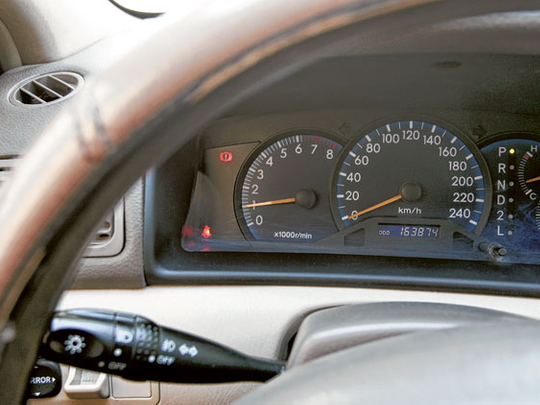
Abu Dhabi: Altering a vehicle's odometer to change the actual mileage covered by the vehicle can endanger lives.
Rolling back a car's odometer is one of the oldest tricks in the book. Sadly, it happens frequently, mainly for people buying used cars.
"I purchased a used 2006 model car in May 2011 from a private owner. At that time the car's mileage was approximately 104,500 km. But when I took it for an air conditioning repair job, I was told the car last came to the shop in 2008, with 139,000km mileage. On further enquiry, I was told that the last registration renewal was in March 2010 and the car mileage then was 200,000 km. That means the man who sold me the car tampered with the odometer, and put my family's life in danger," Mohammad Abid told Gulf News.
"Merchants alter odometers to increase their profit and sell the cars for more than they are worth. The odometer reading is the only real indicator of the number of kilometres a car has travelled. So the lower the car mileage, the higher the price," said Abid, a car salesman.
Simple process
It takes simple inexpensive tools to erase thousands of miles from a vehicle's odometer in minutes.
"Older cars have analogue odometers consisting of spinning wheels. Anyone with minor mechanical ability can take the dashboard apart, remove the odometer gauge and adjust the numbers backward or forward," George Antoine, an engineer said.
In the past decade, auto manufacturers began installing digital odometers, hoping that it would eliminate tampering.
"Known computer stores in the capital tamper with the vehicles rather than mechanics because of the digital odometer," said M.M., a mechanic.
"Unfortunately, it is as easy, if not easier, to alter a digital odometer than older versions; the only hard part is detecting the tampering [since digital odometers have no visible moving parts]," Antoine added.
"People think that digital odometers cannot be rolled back. There are companies selling software on the internet so that anyone who wants to roll back even a digital odometer can do it. In a digital odometer, the mileage is usually stored on a chip in the car's central computer. A hacker can easily communicate with the chip, and type in the new mileage," he explained.
Cars with high mileage are more prone to failure, putting the lives of the occupants at risk. The probability of major repairs and lots of little things going wrong is also increased.
Those who tamper with a vehicle's odometer can be booked for cheating customers if they complain to the police, said a police officer in Abu Dhabi.
How to detect fraud
- Examine the dashboard for scratch marks or loose screws. They could indicate your odometer has been tampered with.
- If the vehicle has a traditional mechanical odometer, check if the numbers on the odometer gauge are aligned correctly. If the gauge's numbers are crooked, contain gaps, or jiggle when you hit the dash with your hand, the vehicle may have been involved in odometer tampering.
- Make sure mileage and wear and tear of a vehicle make sense; carefully inspect the vehicle and evaluate whether its condition match the reading on the odometer.
- Compare the mileage on the odometer with the mileage indicated on the vehicle's maintenance records.
- Check the service history of the car. Look for maintenance stickers, such as last oil change - they have mileage at the time of work written on them.
- Check engine hoses, battery, clamp and fan belt for excessive wear.
- Get an honest mechanic to examine the car for you.












